A/B Testing in the HubSpot: Boost Your Conversions
Theoretical approach is good, but when we are discussing your website conversions, the practical one could be much more useful. So, who should you ask about what your customers need? Yourself? Your designer? I believe neither of them. The best way is to directly ask the customer. But how do you do it? In this case, A/B testing could be the perfect solution.
A/B testing, also known as split testing, is a powerful technique in digital marketing that allows you to optimize your website's performance and improve conversion rates. In this blog post, we will explore how to harness the power of A/B testing within the HubSpot CMS to achieve better results and create a more user-friendly and engaging online experience to convert your visitors into customers.
What is A/B Testing?
A/B testing is a method used to compare two versions of a web page or marketing asset to determine which one performs better. By presenting two variations, A and B, to your audience and measuring their responses, you can make data-driven decisions to improve your website's effectiveness. This testing method is crucial for optimizing the user experience, increasing conversions, and achieving your marketing goals.
Why Use HubSpot for A/B Testing?
The answer here is quite simple: starting from the Professional Plan, HubSpot Content Hub has a built-in A/B Testing feature for your emails and pages. Proving any of your theories in practice will not require too much effort. Additionally, HubSpot's intuitive interface makes it easy to create, manage, and analyze A/B tests.
What have to be done before A/B Tests
Before delving into the practical aspect of A/B testing, let's define several things before conducting the test:
Define Your Goals
Start by setting clear objectives for your A/B tests. Ask yourself the following questions:
- What do you want to improve?
- How will you measure success?
- How long should the test run?
After defining the goals, you can shift from asking "what/how" to "which."
Select Elements to Test
Now, you need to choose which elements on your web page you want to test. These can include:
- Headlines (font, size, color)
- Call-to-action (CTA) buttons (including font, size, color, and behavior; you can choose several actions on click and check which action provides better conversion)
- Images (size and type, such as photos or icons; you can also try a version without images at all)
- Forms (here you can change not only the number of fields but also the form elements or the full form design)
- ... and more
Create Variations
Now that you have defined the goals and the elements to test, you need to design two different versions of the element you want to test. HubSpot's native solution can assist with this.
How to enable A/B test in Content Hub?
That was the theory; now let's move on to the practice. As mentioned earlier, you need at least the Professional Plan to run an A/B test. So, select the website page or landing page where you want to perform the test and go to the "more" menu:

then find and click on "Run a test":
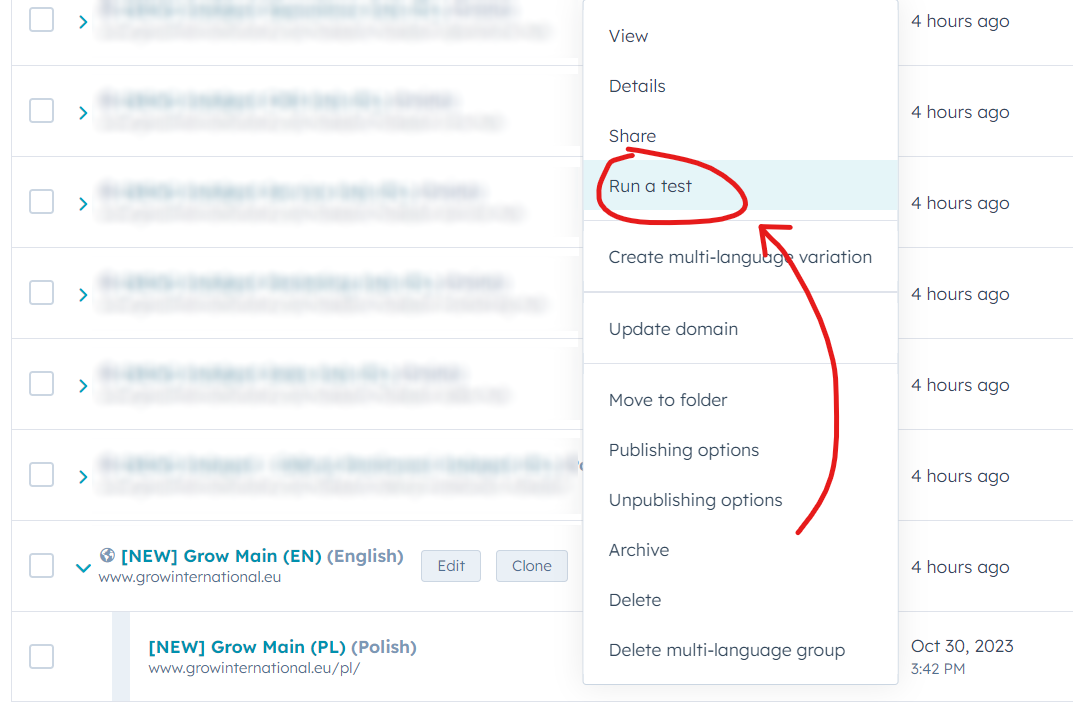
or you can access it from the page editor by locating "Test" in the left menu and selecting "Run A/B test":
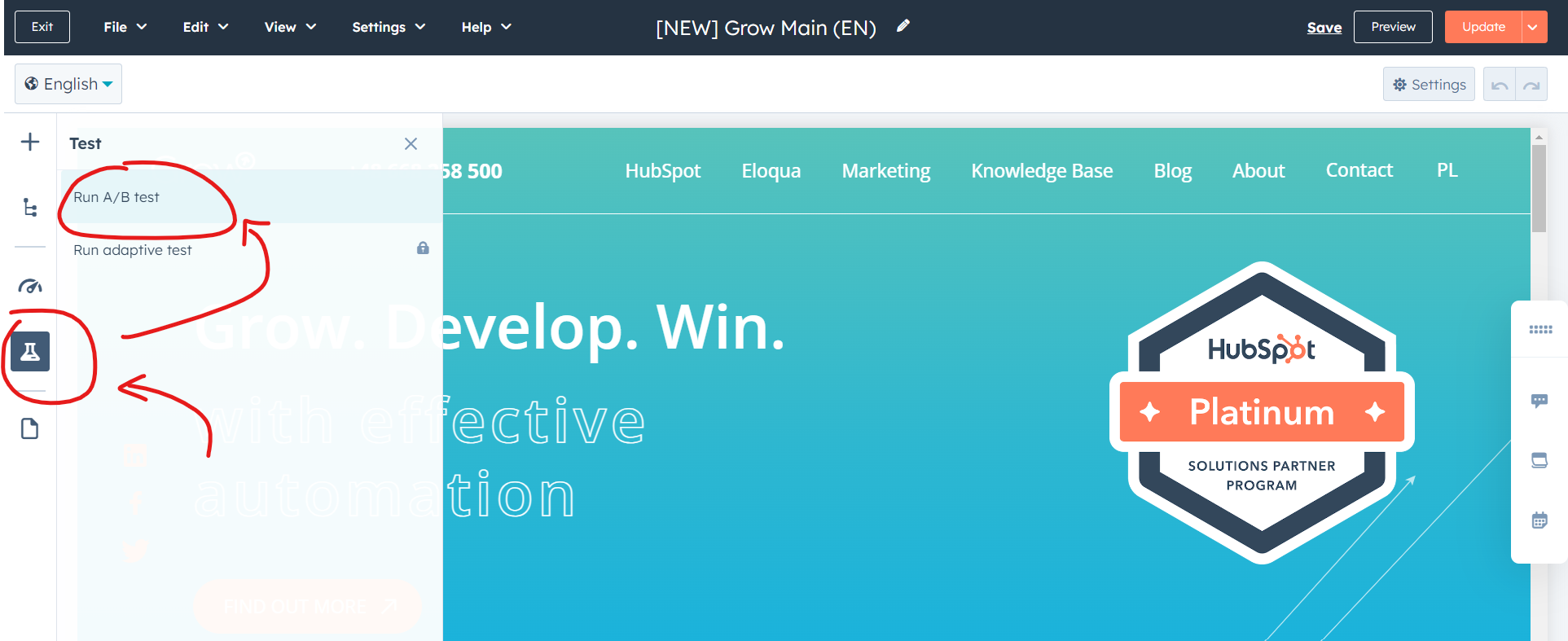
Choose the A/B test option:
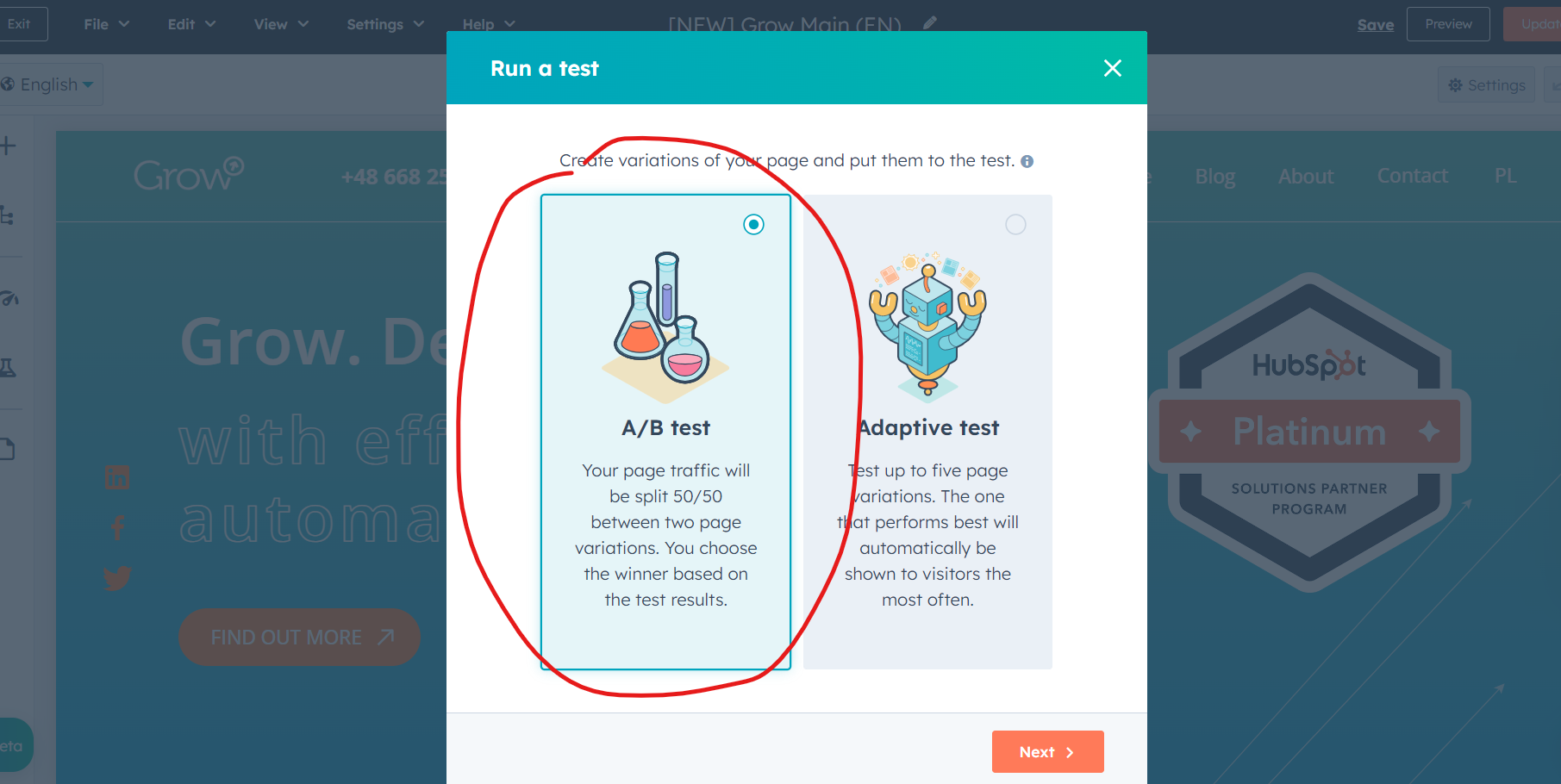
then just choose the names for the variations:
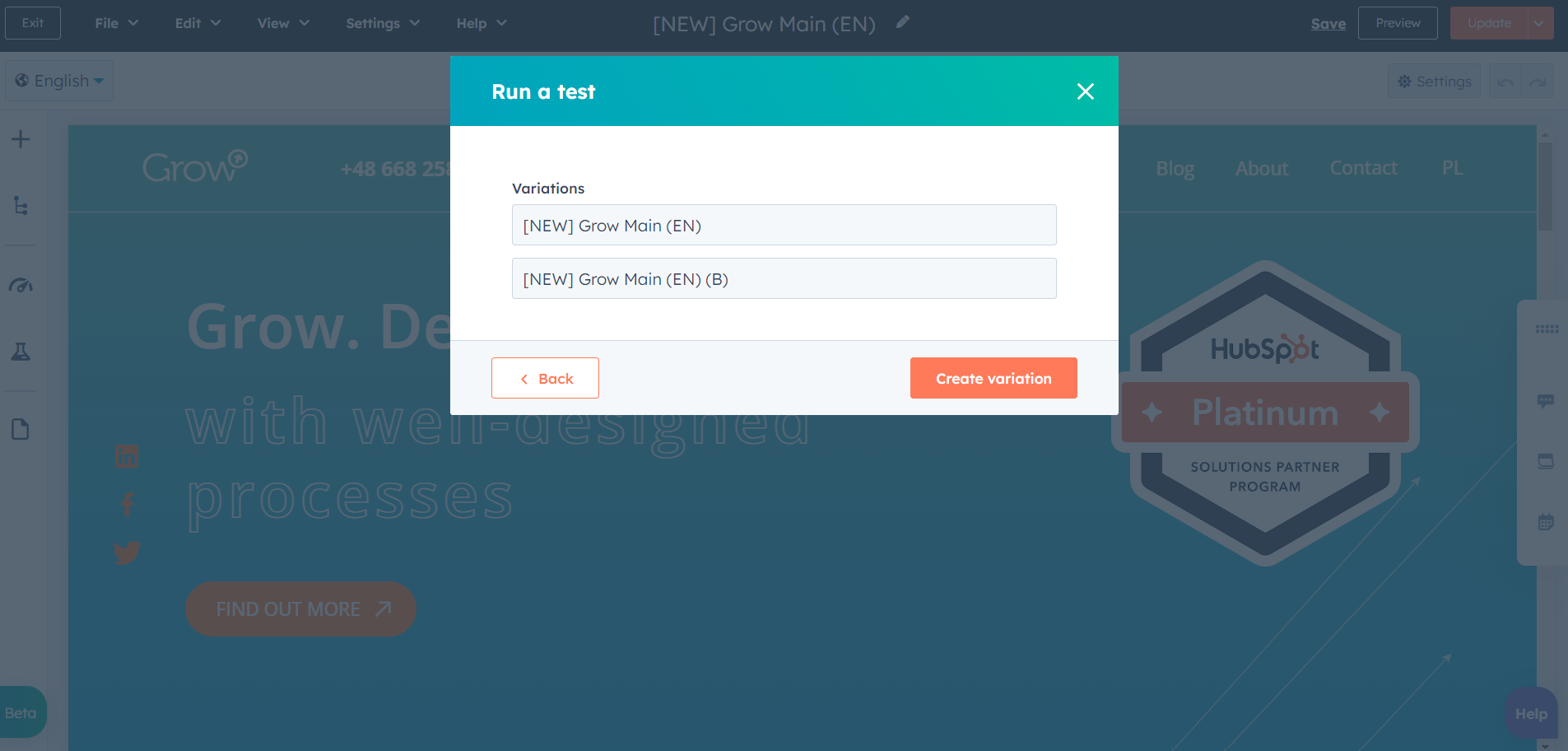
Then, provide names for the variations: Click "Create variation." The test itself is now created. Your task is to change the content in the "B" variation as described earlier. To switch between the variations, use the menu located near the language version switcher.
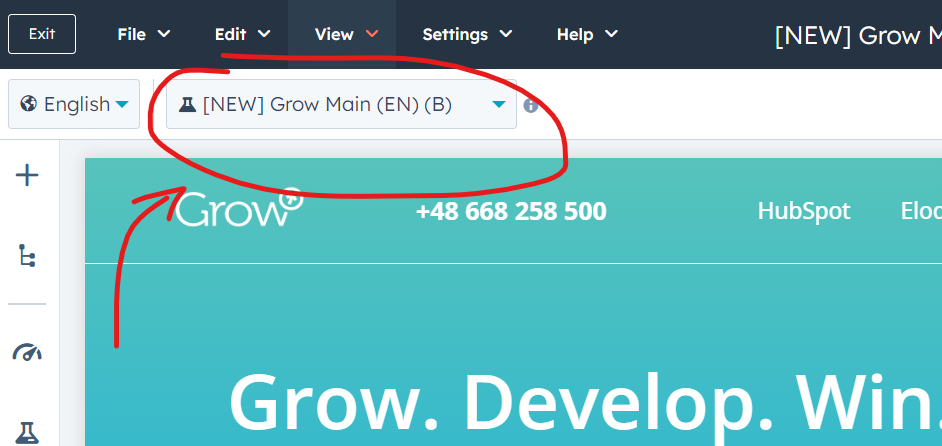
Now that you've created the variation and made the necessary content changes, all that's left to do is wait for a while (as defined in your goals) and let your visitors determine which variation performs better.
Analyzing A/B Test Results
When it comes to analyzing the results, you need to:
- Understand the metrics you're tracking, including conversion rate, bounce rate, and click-through rate, in order to make informed decisions.
- Ensure that the differences between variations are statistically significant to draw valid conclusions.
- Apply the winning variation to your website based on the results. A/B testing is an iterative process, so continue experimenting and refining your site for better conversions over time.
What It Looks Like in HubSpot
To view your test results, go to the page details and select the "Test results" tab:
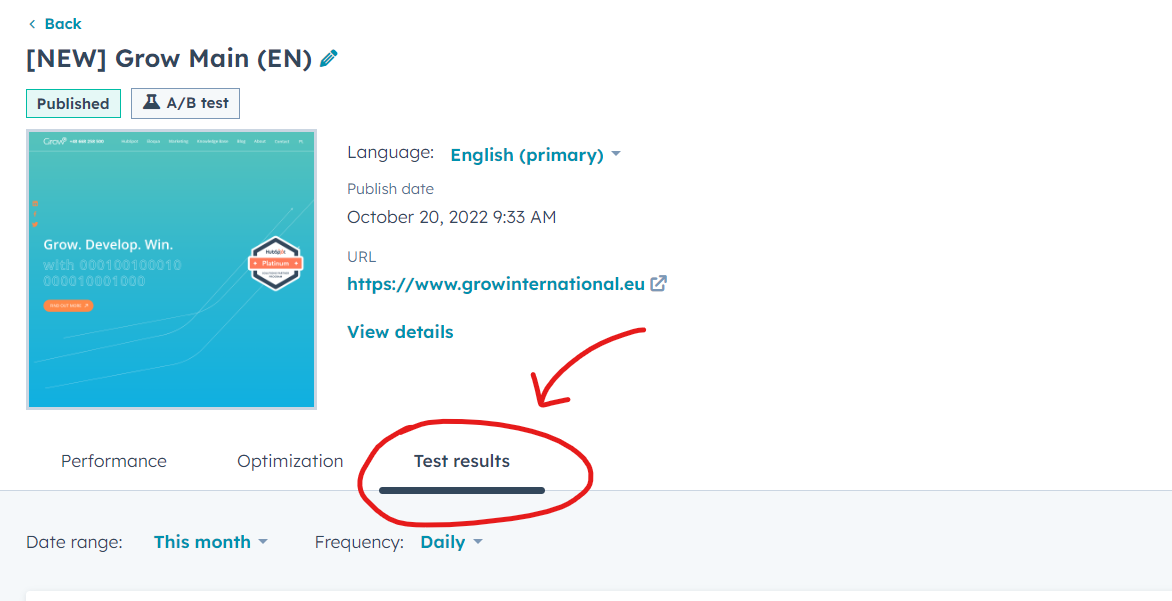
Next, select the period and frequency. Please note that the "All data" period does not cover the entire testing period; it includes data from the time the page was created. It's better to choose the "Custom range" option and review the results from the day the test started to the day it finished.
Here's what the results look like for one of our previous tests:

By default, the results will show you the page views, but you can switch to see other parameters, such as:
- Total form submissions
- New contacts
- Contact-to-customer rate
- New customers
- Bounce rate
- Time per page view
In our case, we tested the conversion rate of our form, which was slightly different in the "B" version. The results were as follows: the "B" version showed a 1% conversion rate, while "A" had only 0.46%. As a result, we chose the "B" version as the winner.
By the way, if you look at the graph in the previous screenshot, you may notice that the views are not evenly split at 50/50; it's more like 70/30. However, conversions are a relative number, so even with such uneven splitting, the test can still be meaningful.
How to apply the winner as the main version?
This is also a part of the native functionality. Simply scroll to the results and hover over the versions:

*Just note that the last variation was created while I was writing this blog post, so it doesn't have any views or submissions yet.
Best Practices for A/B Testing in HubSpot
To maximize the effectiveness of your A/B testing in HubSpot, follow these best practices:
- Hypothesis and Objectives: Clearly define your hypotheses and objectives for each test. What changes do you expect to make, and what are your desired outcomes?
- Sample Size and Duration: Ensure your sample size is statistically significant, and run tests for a sufficient duration to gather reliable data.
- Consistency: Maintain consistency in your testing process to avoid skewing results.
A/B Testing Pitfalls to Avoid
Steer clear of common A/B testing pitfalls, which include:
- Biased Sample Groups: Make sure that your sample groups represent your target audience accurately.
- Overtesting: Avoid running too many tests simultaneously, as this can lead to confusion and unreliable results.
- Premature Conclusions: Allow tests enough time to reach statistical significance before making decisions.
Incorporating A/B testing into your HubSpot strategy can be a game-changer for improving your website's performance and increasing conversions. Make data-driven decisions, continuously refine your content, and reap the benefits of a more effective online presence. Feel free to reach out if you have any questions, and happy testing!




